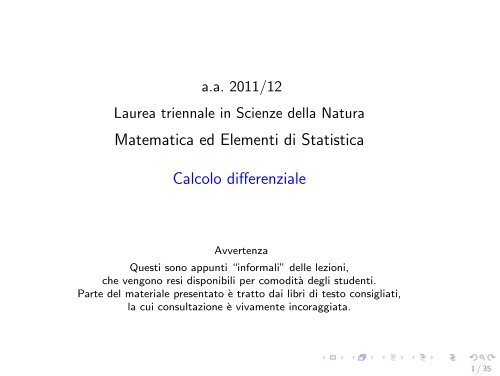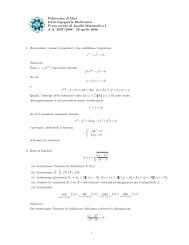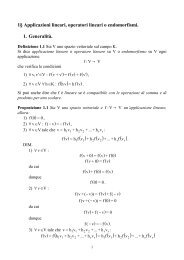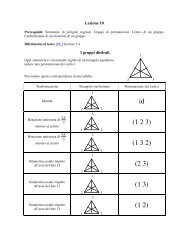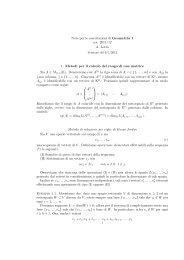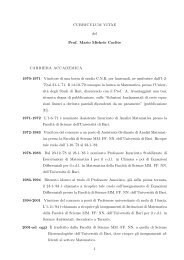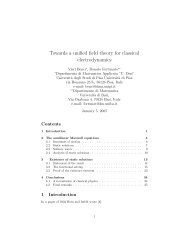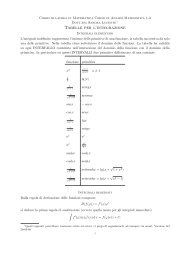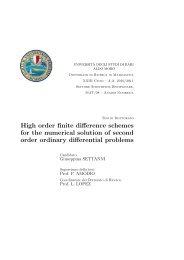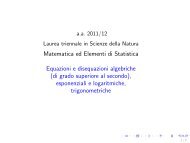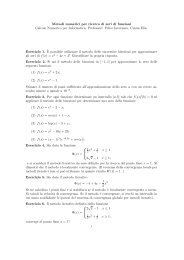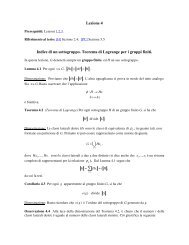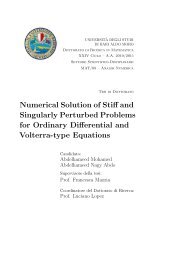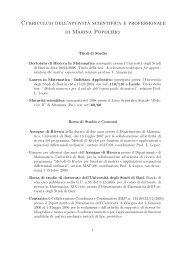lucidi 5 - Dipartimento di Matematica
lucidi 5 - Dipartimento di Matematica
lucidi 5 - Dipartimento di Matematica
Create successful ePaper yourself
Turn your PDF publications into a flip-book with our unique Google optimized e-Paper software.
a.a. 2011/12<br />
Laurea triennale in Scienze della Natura<br />
<strong>Matematica</strong> ed Elementi <strong>di</strong> Statistica<br />
Calcolo <strong>di</strong>fferenziale<br />
Avvertenza<br />
Questi sono appunti “informali” delle lezioni,<br />
che vengono resi <strong>di</strong>sponibili per como<strong>di</strong>tà degli studenti.<br />
Parte del materiale presentato è tratto dai libri <strong>di</strong> testo consigliati,<br />
la cui consultazione è vivamente incoraggiata.<br />
1 / 35
L’idea generale <strong>di</strong> variazione<br />
Spesso più che ai valori <strong>di</strong> una certa grandezza siamo interessati al<br />
modo in cui questi valori cambiano in risposta alla variazione <strong>di</strong> una<br />
certa altra grandezza.<br />
Esempi . . .<br />
Possiamo parlare <strong>di</strong><br />
• variazione assoluta<br />
• variazione me<strong>di</strong>a<br />
• variazione istantanea<br />
Traduciamo matematicamente questi concetti.<br />
2 / 35
Definizione<br />
Sia A un intervallo, sia f : A → R e sia x 0 ∈ A.<br />
Per ogni x ∈ A \ {x 0 } il numero<br />
f (x) − f (x 0 )<br />
x − x 0<br />
si chiama rapporto incrementale <strong>di</strong> f in x 0 , valutato in x .<br />
Osservazione<br />
Il rapporto incrementale corrisponde alla variazione me<strong>di</strong>a della<br />
grandezza espressa da f .<br />
Interpretazione geometrica? Interpretazione cinematica?<br />
Posto h := x − x 0 , possiamo riscrivere il rapporto incrementale in x 0<br />
come f (x 0 + h) − f (x 0 )<br />
, con h ≠ 0.<br />
h<br />
3 / 35
Definizione<br />
Sia f : A → R e sia x 0 ∈ A.<br />
Diciamo che f è derivabile in x 0 se il limite<br />
(<br />
)<br />
f (x) − f (x 0 )<br />
f (x 0 + h) − f (x 0 )<br />
lim<br />
= lim<br />
x→x 0 x − x 0 h→0 h<br />
esiste ed è finito.<br />
Tale limite si chiama derivata <strong>di</strong> f in x 0 e si denota con<br />
• f ′ (x 0 )<br />
(notazione <strong>di</strong> Lagrange), oppure<br />
• df<br />
dx (x 0) (notazione <strong>di</strong> Leibniz). Commenti . . .<br />
Osservazione<br />
La derivata corrisponde alla variazione istantanea della grandezza<br />
espressa da f .<br />
Interpretazione cinematica? Interpretazione geometrica . . .<br />
4 / 35
Proposizione<br />
Se f è derivabile in x 0 , allora è continua in x 0 .<br />
Verifica . . .<br />
Corollario<br />
Se f non è continua in x 0 , allora non è derivabile in x 0 .<br />
Esempio<br />
Le funzioni parte intera e mantissa non sono derivabili in x ∈ Z.<br />
Osservazione<br />
La continuità in un punto è con<strong>di</strong>zione necessaria ma non sufficiente<br />
per la derivabilità.<br />
Per esempio, la funzione f (x) = |x| è continua in x = 0 ma non è<br />
derivabile in x = 0. Perché?<br />
5 / 35
Definizione<br />
Diciamo che f è derivabile a destra [a sinistra] in x 0 se il limite<br />
[<br />
]<br />
x − x 0 x − x 0<br />
f (x) − f (x 0 )<br />
f (x) − f (x 0 )<br />
lim<br />
x→x + 0<br />
esiste ed è finito.<br />
lim<br />
x→x − 0<br />
Tale limite si chiama derivata destra [derivata sinistra] <strong>di</strong> f in x 0 e<br />
si denota con f ′ +(x 0 ) [f ′ −(x 0 )].<br />
Osservazione<br />
Negli estremi <strong>di</strong> un intervallo ha senso considerare solo la derivata<br />
destra o la derivata sinistra.<br />
In un punto interno, f è derivabile se e solo se è derivabile a destra e<br />
a sinistra con derivata destra e sinistra uguali.<br />
Esempio<br />
Per f (x) = |x| si ha f ′ +(0) = 1 e f ′ −(0) = −1.<br />
6 / 35
Definizione<br />
Sia f : A → R, sia x 0 interno ad A e supponiamo che f sia derivabile<br />
in x 0 .<br />
Chiamiamo retta tangente al grafico <strong>di</strong> f in x 0 la retta <strong>di</strong> equazione<br />
Motivazione . . .<br />
y = f (x 0 ) + f ′ (x 0 )(x − x 0 ).<br />
Questa definizione fornisce l’interpretazione geometrica della derivata:<br />
se f è derivabile in x 0 , f ′ (x 0 ) è il coefficiente angolare della retta<br />
tangente al grafico <strong>di</strong> f nel punto <strong>di</strong> coor<strong>di</strong>nate (x 0 , f (x 0 )).<br />
Esempio<br />
Scrivere l’equazione della retta tangente al grafico <strong>di</strong> f (x) = x 2 nel<br />
punto x 0 = 1.<br />
Osservazione<br />
Il grafico della funzione valore assoluto ha in x = 0 un punto<br />
angoloso; non è possibile in<strong>di</strong>viduare la retta tangente.<br />
7 / 35
Definizione<br />
La funzione che a ogni x in cui f è derivabile associa la derivata<br />
<strong>di</strong> f in x si chiama funzione derivata (prima) <strong>di</strong> f e si denota con f ′<br />
(oppure con df<br />
dx ).<br />
Osservazione<br />
dom(f ′ ) ⊆ dom(f ); alle volte l’inclusione è stretta.<br />
Esempio<br />
f (x) = |x|, dom(f ) = R; f ′ (x) = x<br />
|x| , dom(f ′ ) = R ∗ 8 / 35
Derivata <strong>di</strong> alcune funzioni elementari<br />
f (x) = c dom(f ) = R = dom(f ′ ) f ′ (x) = 0<br />
f (x) = ax + b dom(f ) = R = dom(f ′ ) f ′ (x) = a<br />
f (x) = x n (n ≥ 2) dom(f ) = R = dom(f ′ ) f ′ (x) = n x n−1<br />
f (x) = 1 x<br />
dom(f ) = R ∗ = dom(f ′ ) f ′ (x) = − 1<br />
x 2<br />
Osservazione<br />
La terza e quarta formula possono essere riscritte come<br />
f (x) = x p =⇒ f ′ (x) = p x p−1 ,<br />
con p = n e p = −1, rispettivamente. In effetti, questa formula<br />
è valida per qualsiasi p ∈ R (con le opportune restrizioni per x ).<br />
9 / 35
Operazioni con funzioni derivabili<br />
Se f e g sono derivabili in x e c ∈ R, anche le funzioni f + g ,<br />
f − g , f · g , c f sono derivabili in x e si ha<br />
(f + g) ′ (x) = f ′ (x) + g ′ (x) regola della somma<br />
(f − g) ′ (x) = f ′ (x) − g ′ (x) regola della <strong>di</strong>fferenza<br />
(c f ) ′ (x) = c f ′ (x) regola del multiplo<br />
(f · g) ′ (x) = f ′ (x) · g(x) + f (x) · g ′ (x) regola del prodotto<br />
1<br />
Se g(x) ≠ 0, anche le funzioni<br />
g e f sono derivabili in x e si ha<br />
g<br />
( 1<br />
) ′(x) g ′ (x) = −<br />
g (g(x)) 2<br />
regola del reciproco<br />
( f<br />
) ′(x) f ′ (x) · g(x) − f (x) · g ′ (x)<br />
=<br />
g<br />
(g(x)) 2<br />
regola del rapporto<br />
10 / 35
Corollario<br />
La somma, la <strong>di</strong>fferenza, il prodotto, la combinazione lineare,<br />
il reciproco, il rapporto <strong>di</strong> funzioni derivabili sono funzioni derivabili<br />
nei rispettivi domini.<br />
Osservazione (da ricordare!)<br />
Sono derivabili nei rispettivi domini<br />
• le funzioni polinomiali (combinazioni lineari <strong>di</strong> funzioni derivabili),<br />
• le funzioni razionali (rapporti <strong>di</strong> funzioni derivabili).<br />
Esempi<br />
Calcolare le derivate delle seguenti funzioni:<br />
f (x) = 6 x 5 − 2x f (x) =<br />
f (x) = 3 x 4 + 5 x<br />
1<br />
5x 3 + 2x − 1<br />
f (x) = 3x 2 − 2x + 1<br />
x 3 − x<br />
11 / 35
Composizione <strong>di</strong> funzioni derivabili<br />
Siano f e g due funzioni tali che la funzione composta f ◦g sia<br />
definita in un intorno <strong>di</strong> x .<br />
Se g è derivabile in x e f è derivabile in g(x), allora la funzione<br />
composta è derivabile in x e si ha<br />
(f ◦g) ′ (x) = f ′ (g(x)) · g ′ (x).<br />
Nota: questa regola si generalizza alla composizione <strong>di</strong> tre o più<br />
funzioni. Per esempio:<br />
(f ◦g ◦h) ′ (x) = f ′ (g(h(x))) · g ′ (h(x)) · h ′ (x).<br />
Corollario<br />
La funzione composta <strong>di</strong> due o più funzioni derivabili nei rispettivi<br />
domini è una funzione derivabile nel proprio dominio.<br />
Esempio<br />
Calcolare la derivata <strong>di</strong> f (x) = (3x 2 − 4x + 1) 5 . Derivata <strong>di</strong> f n ?<br />
12 / 35
Funzione inversa <strong>di</strong> una funzione derivabile<br />
Sia f la funzione inversa <strong>di</strong> una funzione g , strettamente monotona e<br />
continua in un intervallo.<br />
Sia x ∈ dom(f ). Se g è derivabile in f (x) con g ′ (f (x)) ≠ 0, allora:<br />
f è derivabile in x con<br />
f ′ (x) =<br />
1<br />
g ′ (f (x)) .<br />
Interpretazione<br />
geometrica?<br />
Esempio<br />
La funzione ra<strong>di</strong>ce n-esima f (x) = n√ x è derivabile in dom(f ) \ {0}<br />
con f ′ 1<br />
(x) =<br />
n n√ . (Formula <strong>di</strong> pagina 9 con p = 1/n . . . )<br />
x n−1<br />
Nota: in x = 0 la regola <strong>di</strong> derivazione non è applicabile; il calcolo<br />
<strong>di</strong>retto mostra che il limite del rapporto incrementale in x = 0 è +∞.<br />
Punto/flesso a tangente verticale<br />
13 / 35
Derivata <strong>di</strong> ulteriori funzioni elementari<br />
f (x) f ′ (x) f (x) f ′ (x)<br />
e x e x ln(x)<br />
p x ln(p) p x log p (x)<br />
sin(x) cos(x) arcsin(x)<br />
1<br />
x<br />
1<br />
ln(p) x<br />
1<br />
√<br />
1 − x 2<br />
1<br />
cos(x) − sin(x) arccos(x) −√ 1 − x 2<br />
(x ≠ ±1)<br />
(x ≠ ±1)<br />
tan(x)<br />
1<br />
(cos(x)) 2<br />
= 1 + (tan(x)) 2<br />
arctan(x)<br />
1<br />
1 + x 2<br />
Nota: prendendo per buone le derivate in rosso, tutte le altre si possono ricavare attraverso<br />
le regole <strong>di</strong> derivazione.<br />
14 / 35
Esempi<br />
Calcolare le derivate delle seguenti funzioni applicando le regole <strong>di</strong><br />
derivazione.<br />
f (x) = 2 x − sin(x) f (x) = arcsin(4x 2 )<br />
f (x) = e 1/x f (x) = (x 2 + 2e 3x − tan(x)) 4<br />
f (x) = |x| e x f (x) = (x − 1) 3√ x 2 − 3x + 2<br />
f (x) = cos(x 4 − 3e x )<br />
e x 15 / 35
Definizione<br />
Sia f una funzione derivabile in un insieme A e sia x 0 ∈ A.<br />
Diciamo che f è derivabile due volte in x 0 se la funzione f ′ è<br />
derivabile in x 0 .<br />
Il numero f ′′ (x 0 ) := (f ′ ) ′ (x 0 ) si chiama derivata seconda <strong>di</strong> f in x 0 ;<br />
la funzione f ′′ := (f ′ ) ′ si chiama funzione derivata seconda <strong>di</strong> f .<br />
Notazione alternativa:<br />
d 2 f<br />
dx 2<br />
Osservazione<br />
In maniera iterativa, si introduce la nozione <strong>di</strong> funzione derivabile tre<br />
volte, quattro volte, e così via, e si definisce la funzione derivata terza,<br />
quarta, e così via; la derivata n-esima <strong>di</strong> f si denota con f (n) .<br />
d n f<br />
Notazione alternativa:<br />
dx n<br />
Esempio<br />
Determinare la derivata seconda e la derivata terza della funzione<br />
f (x) = x 2 e x .<br />
16 / 35
Alcune applicazioni del calcolo <strong>di</strong>fferenziale<br />
• Ricerca <strong>di</strong> estremi locali e globali <strong>di</strong> una funzione<br />
• Stu<strong>di</strong>o della monotonia e della convessità <strong>di</strong> una funzione<br />
• Stu<strong>di</strong>o del grafico <strong>di</strong> una funzione<br />
• Risoluzione qualitativa <strong>di</strong> equazioni<br />
• Risoluzione <strong>di</strong> alcune forme <strong>di</strong> indecisione<br />
17 / 35
Proposizione<br />
Sia A un intervallo.<br />
Sia f : A → R derivabile in x 0 punto interno ad A.<br />
• Se f ′ (x 0 ) > 0, allora f è crescente in x 0 , cioè :<br />
x vicino a x 0 , a sinistra =⇒ f (x) < f (x 0 )<br />
x vicino a x 0 , a destra =⇒ f (x) > f (x 0 )<br />
• Se f ′ (x 0 ) < 0, allora f è decrescente in x 0 , cioè :<br />
x vicino a x 0 , a sinistra =⇒ f (x) > f (x 0 )<br />
x vicino a x 0 , a destra =⇒ f (x) < f (x 0 )<br />
Motivazione . . .<br />
Confronto tra le nozioni “(de)crescente in un punto” e “(de)crescente<br />
in un intervallo” . . .<br />
18 / 35
Corollario (Criterio per la ricerca <strong>di</strong> punti <strong>di</strong> estremo locale)<br />
Sia f : A → R e sia x 0 ∈ A un punto <strong>di</strong> estremo locale. Allora:<br />
• x 0 è un estremo <strong>di</strong> A, oppure<br />
• x 0 è un punto interno ad A in cui f non è derivabile, oppure<br />
• x 0 è un punto interno ad A in cui f è derivabile e f ′ (x 0 ) = 0<br />
(punto stazionario).<br />
Interpretazione geometrica<br />
In un punto <strong>di</strong> estremo locale interno ad A la tangente al grafico <strong>di</strong> f ,<br />
se esiste, è orizzontale.<br />
Esempio<br />
In<strong>di</strong>viduare i possibili punti <strong>di</strong> estremo locale per le funzioni<br />
f 1 (x) = |x|(1 − x 2 ), f 2 (x) = x 2 (1 − x 2 ), f 3 (x) = x 3 (1 − x 2 )<br />
Osservazione<br />
I punti stazionari non sono necessariamente punti <strong>di</strong> estremo locale.<br />
19 / 35
Osservazione<br />
Sia x 0 un punto interno al dominio <strong>di</strong> una funzione continua,<br />
can<strong>di</strong>dato punto <strong>di</strong> estremo locale. Cioè ?<br />
Se in x 0 vi è un cambiamento <strong>di</strong> monotonia, allora x 0 è un punto <strong>di</strong><br />
estremo locale. Precisamente:<br />
monotonia <strong>di</strong> f monotonia <strong>di</strong> f classificazione <strong>di</strong> x 0<br />
vicino a x 0 , a sinistra vicino a x 0 , a destra<br />
crescente decrescente punto <strong>di</strong> massimo locale<br />
decrescente crescente punto <strong>di</strong> minimo locale<br />
Se f ha lo stesso tipo <strong>di</strong> monotonia a sinistra e a destra <strong>di</strong> x 0 , allora<br />
x 0 non è un punto <strong>di</strong> estremo locale. Esempio?<br />
Ne segue che per classificare un can<strong>di</strong>dato punto <strong>di</strong> estremo locale è<br />
utile stabilire con<strong>di</strong>zioni sufficienti per la monotonia <strong>di</strong> una funzione<br />
in un intervallo.<br />
20 / 35
Premessa: legame tra variazione me<strong>di</strong>a e variazione istantanea<br />
Teorema del valor me<strong>di</strong>o (o <strong>di</strong> Lagrange)<br />
Sia A un intervallo.<br />
Sia f : A → R, continua in A e derivabile nei punti interni ad A.<br />
Allora: per ogni x 1 , x 2 ∈ A esiste ¯x compreso tra x 1 e x 2 tale che<br />
f (x 2 ) − f (x 1 )<br />
x 2 − x 1<br />
= f ′ (¯x).<br />
coefficiente angolare della<br />
retta secante<br />
variazione me<strong>di</strong>a<br />
coefficiente angolare della<br />
retta tangente<br />
variazione istantanea<br />
21 / 35
Criterio <strong>di</strong> monotonia<br />
Sia f : [a, b] → R.<br />
Supponiamo f continua in [a, b] e derivabile in (a, b).<br />
• f ′ (x) > 0 ∀ x ∈ (a, b) =⇒ f strettamente crescente in [a, b].<br />
• f ′ (x) < 0 ∀ x ∈ (a, b) =⇒ f strettamente decrescente in [a, b].<br />
Motivazione . . .<br />
Esempio<br />
Stu<strong>di</strong>are la monotonia della funzione esponenziale e della funzione<br />
arcotangente.<br />
22 / 35
Test della derivata prima<br />
Sia f : A → R una funzione continua e sia x 0 interno ad A can<strong>di</strong>dato<br />
punto <strong>di</strong> estremo locale. Supponiamo f derivabile vicino a x 0 .<br />
Se, per x vicino a x 0 , f ′ (x) ha segni <strong>di</strong>scor<strong>di</strong> a sinistra e a destra <strong>di</strong><br />
x 0 , allora x 0 è un punto <strong>di</strong> estremo locale. Precisamente:<br />
segno <strong>di</strong> f ′ segno <strong>di</strong> f ′ classificazione <strong>di</strong> x 0<br />
vicino a x 0 , a sinistra vicino a x 0 , a destra<br />
f ′ (x) > 0 f ′ (x) < 0 punto <strong>di</strong> massimo locale<br />
f ′ (x) < 0 f ′ (x) > 0 punto <strong>di</strong> minimo locale<br />
Se, per x vicino a x 0 , f ′ (x) ha lo stesso segno a sinistra e a destra <strong>di</strong><br />
x 0 , allora x 0 non è un punto <strong>di</strong> estremo locale.<br />
Esempio<br />
Classificare i can<strong>di</strong>dati punti <strong>di</strong> estremo locale per la funzione<br />
f 1 (x) = |x|(1 − x 2 ).<br />
23 / 35
Test della derivata seconda<br />
Sia f : A → R una funzione derivabile e sia x 0 interno ad A punto<br />
stazionario. Supponiamo f derivabile due volte in x 0 .<br />
• Se f ′′ (x 0 ) > 0, allora x 0 è un punto <strong>di</strong> minimo locale.<br />
• Se f ′′ (x 0 ) < 0, allora x 0 è un punto <strong>di</strong> massimo locale.<br />
Motivazione:<br />
f ′′ (x 0 ) > 0 =⇒ f ′ crescente in x 0 =⇒<br />
a sinistra <strong>di</strong> x 0 : f ′ (x) < f ′ (x 0 ) = 0; a destra <strong>di</strong> x 0 : f ′ (x) > f ′ (x 0 ) = 0<br />
Osservazione<br />
Se f ′′ (x 0 ) = 0, questo test non è utilizzabile.<br />
Esempi<br />
Classificare i can<strong>di</strong>dati punti <strong>di</strong> estremo locale per le funzioni<br />
f 2 (x) = x 2 (1 − x 2 ), f 3 (x) = x 3 (1 − x 2 ).<br />
24 / 35
Definizione<br />
Sia A un intervallo e sia f : A → R una funzione derivabile.<br />
Diciamo che f è<br />
• (strettamente) convessa se per ogni x 0 ∈ A si ha<br />
f (x) > f (x 0 ) + f ′ (x 0 )(x − x 0 ) ∀ x ∈ A \ {x 0 }<br />
• (strettamente) concava se per ogni x 0 ∈ A si ha<br />
f (x) < f (x 0 ) + f ′ (x 0 )(x − x 0 ) ∀ x ∈ A \ {x 0 }<br />
il grafico <strong>di</strong> f<br />
è al <strong>di</strong> sopra<br />
della retta<br />
tangente in x 0<br />
il grafico <strong>di</strong> f<br />
è al <strong>di</strong> sotto<br />
della retta<br />
tangente in x 0<br />
Se f è convessa a sinistra <strong>di</strong> x 0 e concava a destra <strong>di</strong> x 0 , o viceversa,<br />
<strong>di</strong>ciamo che x 0 è un punto <strong>di</strong> flesso.<br />
Osservazione<br />
In un punto <strong>di</strong> flesso la tangente al grafico <strong>di</strong> f attraversa il grafico.<br />
Flessi a tangente verticale / orizzontale . . .<br />
25 / 35
Criterio <strong>di</strong> convessità<br />
Sia A un intervallo e sia f : A → R una funzione derivabile due volte.<br />
• f ′′ (x) > 0 ∀ x ∈ A =⇒ f strettamente convessa in A.<br />
• f ′′ (x) < 0 ∀ x ∈ A =⇒ f strettamente concava in A.<br />
Interpretazione geometrica della derivata seconda . . .<br />
Osservazioni<br />
In un punto <strong>di</strong> flesso la derivata seconda, se esiste, si annulla.<br />
Non vale il viceversa. Esempio?<br />
I punti <strong>di</strong> flesso sono punti <strong>di</strong> estremo locale per la derivata prima.<br />
Interpretazione “pratica”?<br />
Esempio<br />
Stu<strong>di</strong>are la convessità e determinare i punti <strong>di</strong> flesso delle funzioni<br />
elementari.<br />
26 / 35
Esempio (da ricordare)<br />
Stu<strong>di</strong>are le proprietà asintotiche, <strong>di</strong> monotonia e <strong>di</strong> convessità delle<br />
seguenti funzioni, definite a partire dalle funzioni esponenziali:<br />
• funzione Gaussiana<br />
• funzioni iperboliche<br />
Esempio<br />
Determinare graficamente il numero <strong>di</strong> soluzioni delle equazioni<br />
(1) x 3 − 3x + 1 = 0<br />
( ) x + 1<br />
(2) ln + x + 4 = 0<br />
x<br />
27 / 35
Caratterizzazione delle funzioni a derivata nulla<br />
Sia f una funzione continua in un intervallo A.<br />
Allora: f ha derivata identicamente nulla in A se e solo se f è una<br />
funzione costante.<br />
Motivazione . . .<br />
Esempio<br />
Cosa si può dedurre dall’uguaglianza d dx<br />
(arcsin(x) + arccos(x)) ≡ 0?<br />
Osservazione<br />
Due funzioni aventi la stessa derivata in un intervallo <strong>di</strong>fferiscono per<br />
una costante ad<strong>di</strong>tiva. Perché?<br />
28 / 35
Osservazione<br />
La caratterizzazione delle funzioni a derivata nulla si può riformulare<br />
<strong>di</strong>cendo che le funzioni costanti sono tutte e sole le soluzioni<br />
dell’equazione <strong>di</strong>fferenziale<br />
f ′ (x) = 0, x ∈ A (A intervallo).<br />
Analogamente, le funzioni lineari sono tutte e sole le soluzioni<br />
dell’equazione <strong>di</strong>fferenziale<br />
Esplicitando:<br />
f ′ (x) = costante, x ∈ A (A intervallo).<br />
• se f (x) = a x + b, allora f ′ (x) = a;<br />
• se f ′ (x) = c per ogni x in un intervallo A, allora esiste k ∈ R<br />
tale che f (x) = c x + k per ogni x ∈ A.<br />
Verifica . . .<br />
(segue)<br />
29 / 35
Inoltre, le funzioni esponenziali sono tutte e sole le soluzioni<br />
dell’equazione <strong>di</strong>fferenziale<br />
Esplicitando:<br />
f ′ (x) = costante · f (x), x ∈ A (A intervallo).<br />
• se f (x) = a e cx , allora f ′ (x) = c f (x);<br />
• se f ′ (x) = c f (x) per ogni x in un intervallo A, allora esiste<br />
k ∈ R tale che f (x) = k e cx per ogni x ∈ A.<br />
Verifica . . .<br />
Esempio<br />
Modello <strong>di</strong> Malthus per la <strong>di</strong>namica <strong>di</strong> popolazione<br />
(o evoluzione demografica) . . .<br />
30 / 35
Regola <strong>di</strong> de l’Hôpital<br />
Siano f e g due funzioni tali che abbia senso calcolare il limite <strong>di</strong><br />
per x che tende a x 0 ∈ R ∪ {−∞, +∞}. Supponiamo che:<br />
(a) f e g siano entrambe infinitesime oppure entrambe infinite<br />
per x che tende a x 0 ;<br />
(b) f e g siano derivabili vicino a x 0 ;<br />
(c) esista il limite<br />
f ′ (x)<br />
lim<br />
x→x 0 g ′ = l ∈ R ∪ {−∞, +∞}.<br />
(x)<br />
Allora:<br />
anche il rapporto f (x)<br />
g(x) ammette limite in x 0 e si ha<br />
lim<br />
x→x 0<br />
f (x)<br />
g(x) = l. 31 / 35<br />
f<br />
g
Esempi<br />
Calcolare<br />
lim<br />
x→1<br />
ln(x)<br />
1 − x 2 , lim sin(x) − x<br />
x→0 x 5 .<br />
Ruolo delle ipotesi<br />
Se (a) non è sod<strong>di</strong>sfatta, non è detto che il limite <strong>di</strong><br />
f ′<br />
x<br />
limite <strong>di</strong> . Esempio: lim<br />
g ′<br />
x→1 + ln(x)<br />
f<br />
g<br />
sia uguale al<br />
Se (c) non è sod<strong>di</strong>sfatta, nulla può <strong>di</strong>rsi sul limite <strong>di</strong><br />
x − sin(x)<br />
esistere o non esistere. Esempio: lim<br />
x→+∞ x + sin(x)<br />
Nota:<br />
sin(x)<br />
lim = 0 per “convergenza obbligata”<br />
x→+∞ x<br />
f<br />
, che può<br />
g<br />
32 / 35
Terminologia<br />
Siano f e g funzioni entrambe infinite oppure entrambe infinitesime<br />
f (x)<br />
per x → x 0 , tali che esista il limite lim =: l ∈ R ∪ {−∞, +∞}.<br />
x→x0 g(x)<br />
l ∈ R ∗ f e g sono infiniti<br />
infinitesimi<br />
dello stesso or<strong>di</strong>ne<br />
l = 0 f è<br />
infinito <strong>di</strong> or<strong>di</strong>ne inferiore<br />
infinitesimo <strong>di</strong> or<strong>di</strong>ne superiore<br />
in simboli: f (x) = o(g(x)), x → x 0<br />
rispetto a g;<br />
l = ±∞ f è<br />
infinito <strong>di</strong> or<strong>di</strong>ne superiore<br />
infinitesimo <strong>di</strong> or<strong>di</strong>ne inferiore<br />
rispetto a g<br />
Esempio<br />
Siano p > q > 0; la funzione x ↦→ x p è infinito [infinitesimo] <strong>di</strong> or<strong>di</strong>ne<br />
superiore rispetto alla funzione x ↦→ x q per x → +∞ [x → 0].<br />
33 / 35
Esempio (gerarchia degli infiniti)<br />
Per x → +∞, le funzioni<br />
x ↦→ p x (p > 1), x ↦→ x α (α > 0), x ↦→ log q (x)<br />
sono tutte e tre infinite. Con la regola <strong>di</strong> de l’Hôpital proviamo che<br />
p x<br />
lim<br />
x→+∞ x α = +∞,<br />
lim<br />
x→+∞<br />
x α<br />
log q (x) = { +∞ se q > 1<br />
−∞ se 0 < q < 1 ,<br />
cioè: per x che tende a +∞,<br />
• la funzione esponenziale <strong>di</strong> base maggiore <strong>di</strong> 1 è infinito <strong>di</strong> or<strong>di</strong>ne<br />
superiore rispetto alla potenza con esponente positivo,<br />
• la potenza con esponente positivo è infinito <strong>di</strong> or<strong>di</strong>ne superiore<br />
rispetto al logaritmo.<br />
Esempi<br />
√ x − ln(x),<br />
lim<br />
x→+∞<br />
lim<br />
x→+∞<br />
3 x − x 2<br />
2 x + x 3 34 / 35
Esercizio<br />
Stu<strong>di</strong>are le proprietà asintotiche, la monotonia e la convessità della<br />
funzione f (x) = x ln(x), tracciarne un grafico approssimativo e<br />
utilizzarlo per determinare il numero delle soluzioni dell’equazione<br />
f (x) = λ, al variare <strong>di</strong> λ ∈ R.<br />
35 / 35


